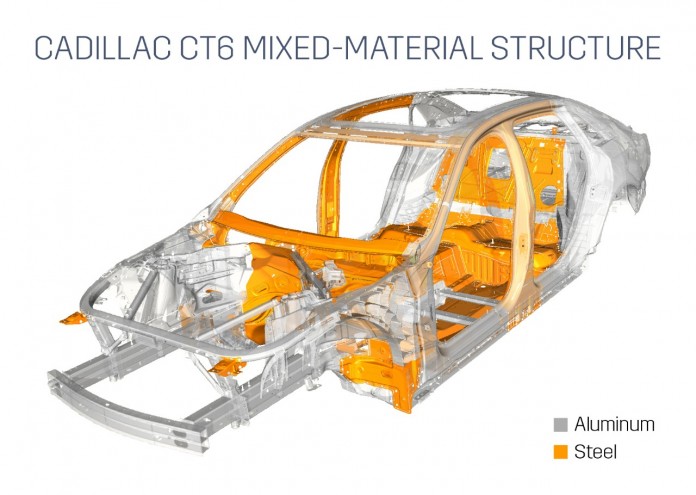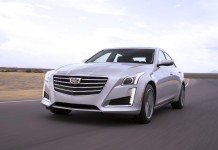Cadillac is already making great strides in restoring its name as the standard of the world, but with the upcoming CT6, the brand is taking the next step in positioning itself as a dominating power in engineering and efficiency. GM recently revealed that the new sedan will make extensive use of various lightweight materials including aluminum alloys to drastically cut weight while preserving strength and rigidity. The CT6 will be one of the first GM most advance models in terms of its construction that will see high-strength steel make up much of the center tub with strength aluminum alloys creating the rest of the outer shell.
The picture above is a representation of how the new car is being constructed to give everyone a better idea of how the car is being built.
Building a car in this fashion has presented its own struggles and currently GM has more than 20 patents pending based on what is learned and developed to successfully combine these materials in new ways that are quicker, safer and stronger than ever.
There has been no real talk of just how much weight this is actually going to save in the car just yet, but the CT6 is still early in the development stages, and we expect much of this information to be released at a later date. If you want to read more about the structure of the CT6, we have included GM’s full press release below.
Press Release
Cadillac CT6 Elevates the Science of Mass Efficiency
2015-03-13
Technology
DETROIT – Cadillac will use an advanced mixed-material approach for the lightweight body structure of the upcoming CT6 range-topping sedan. The structure is aluminum intensive, but the new Cadillac also includes 13 different materials customized for each area of the car to simultaneously advance driving dynamics, fuel economy and cabin quietness.
The CT6 will debut March 31 at the New York International Auto Show and go into production late this year at General Motors’ Detroit-Hamtramck assembly plant.
“This is the rocket science of automobile construction and manufacturing today,” said Cadillac President Johan de Nysschen. “With the CT6, we used high-strength aluminum and high-strength steels; lightweight chassis components; we integrate aluminum and steel where it makes sense; we eliminate every gram of mass possible, while achieving world-class performance.”
Weight reduction helps improve fuel efficiency, contributes to desirable vehicle dynamics and aids in creating a more resilient passenger cell. Sixty-four percent of the CT6 body structure is aluminum, including all exterior body panels – and the mixed material approach saved 90 kg (198 pounds) compared to a predominately steel construction.
Thirteen complex high-pressure die cast components make up the lower structure of the CT6 body, along with aluminum sheets and extrusions. The vehicle underbody uses steel close-out panels on the lower structure to create a bank vault-quiet cabin without the added weight of extensive sound-deadening material, often used to compensate for aluminum panels in the occupant compartment.
“The structure of the CT6 is one of the most-advanced body systems we’ve ever produced,” said Travis Hester, Cadillac CT6 executive chief engineer. “The innovation surrounding our joining techniques have enabled us to create a vehicle structure with the highest torsional rigidity of any Cadillac while achieving one of the most mass-efficient vehicles in the segment.”
Cadillac in January revealed a series of high-technology material joining techniques that create a new methodology for assembling the CT6. These enabled engineers to design a completely new structure for which 21 patents are pending.
“This new construction approach has enabled us to produce a world-class vehicle that is larger in size and includes more standard equipment while achieving lower overall mass,” Hester said.
High-strength steel is used strategically to reinforce the body structure, and is also used in conjunction with high-strength aluminum to create a safety cage surrounding the occupants.
The structural portion of the B-pillar is constructed completely of high-strength steel, which was chosen to aid vehicle ingress, egress and visibility, in addition to mass savings and added cabin quietness.
A high-strength aluminum impact bar was added to the rear of the vehicle, and a combination of high-strength aluminum and steel was used for front and side impact zones to further increase passenger safety in the event of collisions.
A combination of aluminum spot welds, steel spot welds, flow drill screws, self-piercing rivets, laser welding, aluminum arc welding and hundreds of feet of structural adhesive are all used in assembling the body of the CT6.
Cadillac has been a leading luxury auto brand since 1902. Today, Cadillac is growing globally, driven by an expanding product portfolio featuring dramatic design and technology. More information on Cadillac appears at www.cadillac.com. Cadillac’s media website with information, images and video can be found at media.cadillac.com.









